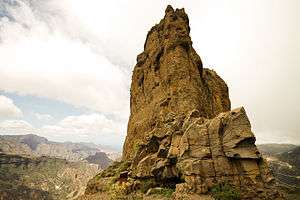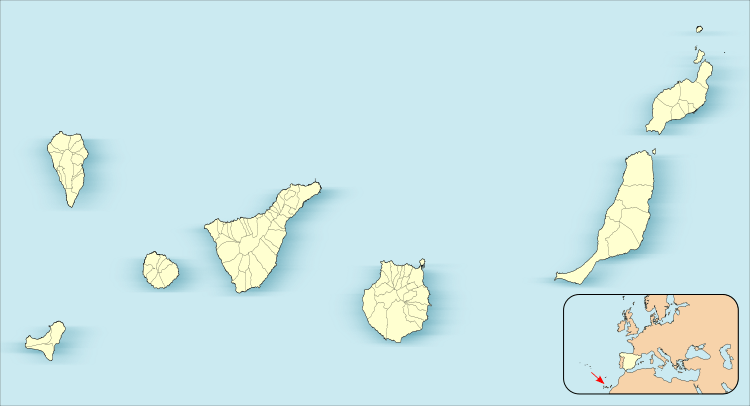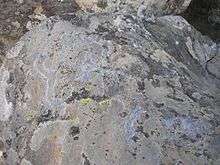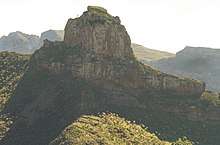Roque Bentayga
Roque Bentayga is a rock formation on the island of Gran Canaria (Canary Islands, Spain). It is located within the volcanic caldera of Tejeda, in the municipality of the same name, in the heart of the island. Roque Bentayga is considered an archaeological monument because it contains an "almogarén"[1] (a sanctuary built by the indigenous Guanche people)[2].
| Roque Bentayga | |
|---|---|
| Rock Bentayga, Bentaiga | |
 View of Roque Bentayga | |
| Highest point | |
| Elevation | 1,414 m (4,639 ft) |
| Coordinates | 27°59′29″N 15°38′31″W |
| Naming | |
| Native name | Bentayga (Guanche) |
| English translation | "Place that supports" |
| Geography | |
 Roque Bentayga | |
| Geology | |
| Mountain type | Volcanic plug |
Characteristics
Roque Bentayga is a natural rock pinnacle. Its height is 1,414 metres (4,639 ft) above sea level. The Roque is located within the Nublo Rural Park.
Archaeology

Near Roque Bentayga are the old Canarian aboriginal settlements of Cuevas del Rey and Roque Camello, which consist of a hundred caves with rooms, burials, silos, etc[1]. On the eastern side of the base of the roque is the so-called "almogarén del Bentayga", a construction that must have been a place of worship for the aborigines. A stone wall that runs along the base of the rock on its east and south sides could delimit the sacred space, although other sources point to its use as a defensive bastion.
Several cave engravings in the Libyan-Berber alphabet have recently been unveiled, although their authenticity is questioned.
Toponymy
The origin of the name "Bentayga" has been widely debated, mainly due to contradictory information collected during the conquest, as well as irregularities in the way of writing and referring to it[3], even about the roots that form the word[4].
One hypothesis is that the voice Bentaiga is composed of two elements: ben-(t)aiga, the first being a prefix with the notion of property or belonging, and the second to the toponym Taiga, from Gran Canaria and Lanzarote, and indirectly with Tigaiga, from Tenerife. Bentaiga would therefore literally mean 'the taiga' or 'place of taiga'. However, the origin of the voice 'taiga' is uncertain[5].
Another interpretation of the term Bentaiga suggests a compound of the numidian word bent meaning 'mountain' and the Mycenaean word aiga (metathesis of agia) meaning 'sacred', thus 'sacred mountain'[6].
The most extended interpretation is the one that sustains that, suggested by the word 'ben-' ('place of'), it means 'place that holds', or 'place that keeps in place', aligning itself with the cosmological and religious ideas of the Guanches, who believed that the place was an axis mundi[7]
Gallery
 Roque Bentayga from Tejeda
Roque Bentayga from Tejeda Meeting place of the former inhabitants of Tejeda.
Meeting place of the former inhabitants of Tejeda. Roque Bentayga's 'almogarén' (place of cult)
Roque Bentayga's 'almogarén' (place of cult) Bentayga as seen from Artenara.
Bentayga as seen from Artenara.
See also
- Parque rural del Nublo
- Roque Nublo
- Tejeda
- Gran Canaria
- Canary Islands
- Guanches
References
- Guía del patrimonio arqueológico de Gran Canaria. Velasco Vázquez, Javier., León Cabrera, Alfonso de., Gran Canaria (Canary Islands). Cabildo Insular. Servicio de Patrimonio Histórico. Departamento de Difusión. (1a ed.). Las Palmas de Gran Canaria: Cabildo de Gran Canaria, Area de Cultura. 2001. ISBN 84-8103-276-X. OCLC 48636631.CS1 maint: others (link)
- http://articles.adsabs.harvard.edu//full/2009ASPC..409..331G/0000331.000.html
- "Los Guanchismos. Diccionario de Toponimia de Canarias". guanchismos.ulpgc.es. Retrieved 2020-07-08.
- "EL LENGUAJE GUANCHE - EL HABLA EN CANARIAS - (GEVIC) Gran Enciclopedia Virtual Islas Canarias". www.gevic.net. Retrieved 2020-07-08.
- "Los Guanchismos. Bentaiga".
For our collaborator Abrahan Loutf the voice Bentaiga is composed of two elements: ben-(t)aiga. The first is a morphematic element, a prefix with the notion of property or belonging, as we have analysed in Benama, and also present in place names such as Bencheque and Benijos in Tenerife, Benigasia and Benama in La Palma, Benicosa, Bentejea, Bentejís and Benticota in El Hierro or Benchijigua in La Gomera. And the lexical element taiga relates directly to the toponym Gran Canaria with the Lanzarote Taiga and indirectly with Tenerife Tiga. Bentaiga would therefore literally mean 'the taiga' or 'place of taiga'. A more insecure question is the identification of the taiga voice. The Berber offers the parallel tagga (takka variant), which is a phytonymic voice with which the wild juniper is called; its distribution in Berber toponymy is hidden under forms such as Tega, Taka or Tiqqi in the simple toponyms and under the compound forms Ain Taya, Ain Taga of mixed Arab-Berber toponyms. On the other hand, according to Laoust (1920: 490), tajga is an indeterminate name for an aquatic plant.
- "Los Guanchismos. Bentaiga".
Very different interpretations are offered by other authors. Thus, Álvarez Delgado (1979: 33-34) believes that it means 'from the mountains', because of its similarity to Agayro, Acayro or Aguayro, "which is effectively worth 'sierra or roque'" -he says-. De Luca (2004: 86) puts the toponym of Gran Canaria in relation to Tigaiga and Teneguía, within which the Berber component agga (variant of uggi), in force in Central Morocco and which would mean 'seeing from above', would act as a lexical element. For his part, V. Masellis (1991: I, 24) has believed that he can interpret the cave inscriptions of the Bentaiga and likewise the term Bentaiga of which he says is a compound of the numeric word bent which means 'mountain' and the Mycenaean word aiga (metathesis of agia) which means 'sacred', therefore 'sacred mountain'.
- "Los Guanchismos. Bentaiga".
Finally, Reyes García (2004b: 228), according to his purpose of dealing with what of the Guanche cosmology was reflected in their language and in the toponymy that has survived, interprets both the Bentaica herreño and the Bentaiga grancanario as 'what sustains', that is, the axis mundi that has been interpreted as one of the central ideas of the cosmology and religious beliefs of the Canarian aborigines.